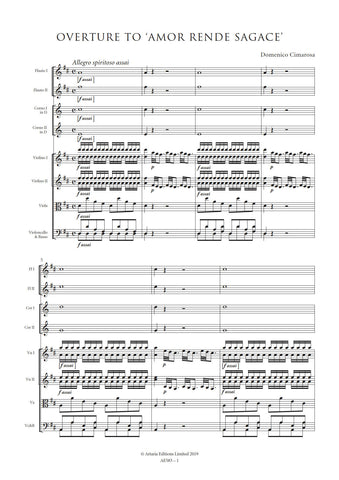Cimarosa, Domenico: Overture to 'Il mercato di Malmantile' (AE265) – sheet music
Previous Product Next Product
Description |
Cimarosa, Domenico (1749-1801)
|
||||||||||||||||
Audio sample |
|||||||||||||||||
Details |
The year 1784 was a busy one for Cimarosa with commissions for opere buffe arriving from Teatro alla Scala in Milan, Teatro della Pergola in Florence, Teatro Regio in Turin, and Teatro dei Fiorentini in Naples, and a request for an opera seria for the 'opening of the (Eretenio) theatre of Vicenza 1784' on 10 July.While the composer responded with five different operas based on five different stories and librettos, he made one overture serve three operas. The sinfonie are exactly the same for Il mercato di malmantile, L'apparenza ingana osia La villeggiature, and L'Olimpiade. And to confuse matters further, a number of publications list Il mercato di Malmantile (The Market of Malmantile) under the title La vanit deluse (Illusive Vanity) as does the present writer in his own book written with Talmage Fauntleroy, Domenico Cimarosa: His Life and His Operas (Greenwood Press, 1999) simply because the opera is better known in our own time under this rubric. One notes that Goldoni's original libretto is titled Il mercato di Malmantile and that it had already been set by Baldassare Galuppi and Polisseno Fegejo before Cimarosa made use of it. The first printed libretto for a production of Cimarosa's opera entitled the work La vanità delusa, while the holograph score bears the title in Cimarosa's own hand, Il mercato di Malmantile. The story is a simple one, a typical Goldoni comedy. The city of Malmantile (an imaginary location) is governed by Sempronio, a man whose every action is dictated by his daughter, Lindora. She is in love with Conte della Rocca, who returns her amorous interests even though the Marchesa Belfaggio is trying her best to woo him through flattery. The arrival of Scassaganasce - a supposed dentist who pretends to be a very important doctor – complicates matters. Charged with being a cheat, Sassaganasce is saved from prison by Sempronio, who exonerates him at the urging of his daughter. In turn, the jealous Marchesa, out of spite, attempts to turn the citizens against the governor, but, when his amorous attentions turn towards her and he proposes marriage, all ends happily. Although two authorities - J.J. Ftis ('Domenico Cimarosa' in Biographie universelle des musiciens, 1866) and Maria Storni Trevisian (Nel primo centenario di Domenico Cimarosa, 1900) list the opera's first performance as taking place in 1779, the Florentine libretto clearly states 'Regio Teatro di via della Pergola nella primavera del 1784'. The joint authors Flix Clment and Pierre Larousse (Dictionnaire des opras, 1867-69), are wrong in terms of both place and date in their dictionary (Rome, 1789) while Robert Eitner (Quellen-Lexikon, 1900) gives Rome, 1780 followed by Naples, 1784: both are incorrect. The actual first performance took place at Teatro della Pergola in Florence in the spring of 1784. Information on subsequent performances of La vanità delusa are unsubstantiated, but it is likely that this comedy was performed in Paris in 1805. A modern revival took place at the Court Theatre of Naples in 1955 in a revision by Guido Pannain. This edition is based on the holograph score preserved in the library of the Conservatorio di musica S Pietro a Majella, Naples. As is the case with all Cimarosa's autograph material the overture to Il mercato di Malmantile shows signs of having been composed at breakneck speed. Every conceivable notational shortcut is taken and his placement of articulation and dynamic markings is erratic. It has been necessary, therefore, to frequently interpret the composer's intentions and even at times to impose an editorial solution where his own thoughts are not clear. In making sense of Cimarosa's score the style and notation of articulation and dynamic markings have been largely standardised throughout, and, where missing, markings have been reconstructed from parallel passages. These are indicated by the use of dotted slurs or brackets where appropriate. Obvious wrong notes have been corrected without comment; editorial emendations with no authority from the source are placed within brackets. Nick Rossi Allan Badley |
||||||||||||||||
Score Preview (best viewed in full screen mode) |
|||||||||||||||||














